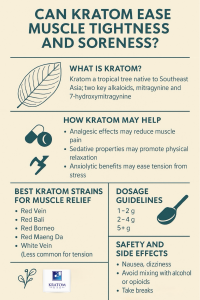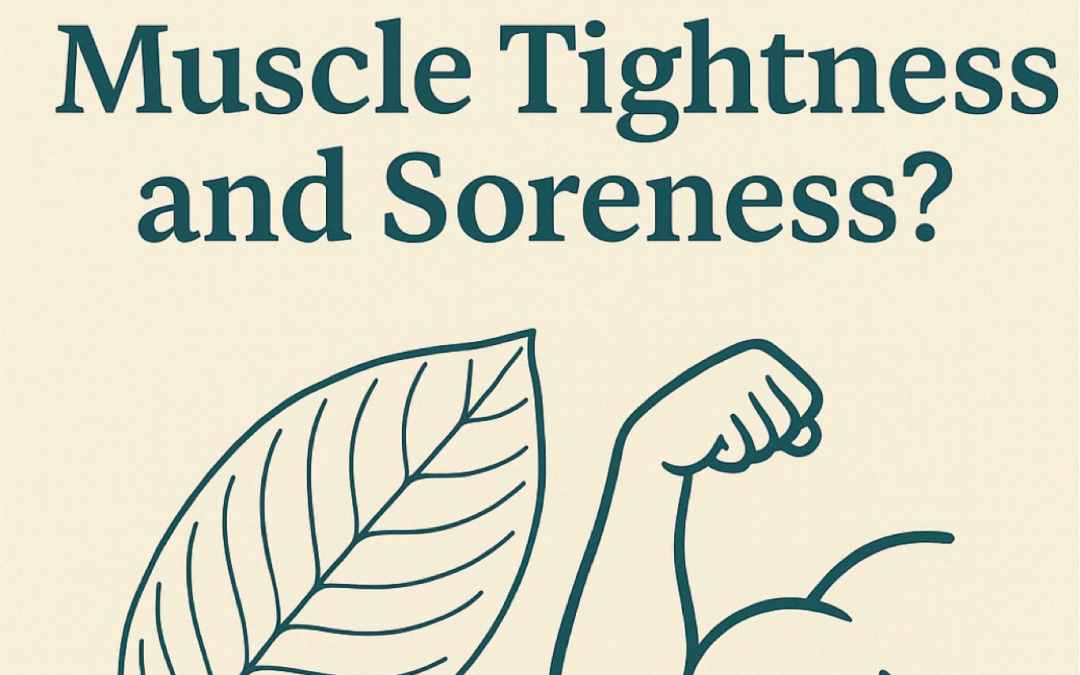How This Ancient Plant May Help Modern-Day Muscle Aches Feel Better
Muscle tightness and soreness are common complaints for people of all walks of life—from athletes and laborers to desk workers and chronic pain sufferers. Whether it’s the aftermath of a tough workout or the result of stress and poor posture, this kind of discomfort can severely impact your quality of life. While over-the-counter medications and prescription muscle relaxants are widely used, many are turning to natural alternatives like kratom for relief. But how effective is kratom for muscle tension? And what does the science actually say?
In this comprehensive guide, we’ll explore how kratom may help ease muscle discomfort, which strains are most effective, what studies and users have to say, and how to use it safely and effectively.
🗝️ Key Points
-
Kratom’s alkaloids may provide pain-relieving, muscle-relaxing, and anti-inflammatory effects.
-
Red and green vein strains are commonly used for muscle tension and recovery.
-
User testimonials suggest that kratom can ease post-workout soreness, stress-related tightness, and chronic pain.
-
Research supports kratom’s analgesic and sedative potential but warns about long-term risks.
-
Proper dosage and strain selection are critical for effectiveness and safety.
🌿 What Is Kratom and Why Do People Use It for Muscle Tension?
 Kratom (Mitragyna speciosa) is a tropical evergreen native to Southeast Asia. For centuries, laborers in Thailand, Indonesia, and Malaysia have chewed kratom leaves or brewed them as tea to relieve fatigue, improve focus, and ease bodily discomfort.
Kratom (Mitragyna speciosa) is a tropical evergreen native to Southeast Asia. For centuries, laborers in Thailand, Indonesia, and Malaysia have chewed kratom leaves or brewed them as tea to relieve fatigue, improve focus, and ease bodily discomfort.
In the U.S., kratom is most commonly consumed as a powder, capsule, or tincture. Its growing popularity in the wellness and recovery communities stems from its unique dual effects:
-
Low doses produce mild stimulation and focus.
-
Moderate to high doses promote relaxation, pain relief, and sedation.
Muscle tension, whether caused by physical strain or nervous system overactivity, may respond well to kratom due to its impact on pain perception, inflammation, and muscle tone.
🔬 The Science Behind Kratom and Muscle Relief
🧪 Alkaloids That Matter:
Kratom contains over 40 alkaloids, but the two most well-studied are:
-
Mitragynine – Binds to opioid receptors and may help dull pain and reduce tension.
-
7-Hydroxymitragynine – A more potent derivative that contributes to sedation and pain relief.
Together, these compounds interact with the brain’s mu-opioid receptors, similar to how mild opioids work—but with a much lower risk of respiratory depression when used properly.
🧠 Mechanisms of Action:
-
Pain Reduction: Kratom can inhibit pain signaling in the central nervous system, easing muscle soreness caused by inflammation or overexertion.
-
Muscle Relaxation: Anecdotal evidence and pharmacological studies suggest that kratom may indirectly act as a GABA agonist, which is a class of compounds known for relaxing the nervous system.
-
Mood and Stress Reduction: By increasing dopamine and serotonin activity, kratom may lower the mental stress that often contributes to muscle tightness.
📖 Source: Hassan Z, Muzaimi M, Navaratnam V, et al. “From Kratom to Mitragynine and Its Derivatives: Physiological and Behavioral Effects Related to Use, Abuse, and Addiction.” Neurosci Biobehav Rev. 2013
💪 Best Kratom Strains for Muscle Tension and Soreness
Not all kratom is created equal. The effects vary greatly depending on the strain, which is generally identified by the vein color of the leaf (red, green, or white).
🔴 Red Vein Kratom – Deep Relaxation & Pain Relief
Best suited for evening use or when soreness and tightness are especially disruptive.
-
Red Bali: Known for its soothing, full-body relaxation. Great for tight back and leg muscles.
-
Red Borneo: Milder than Bali but often preferred for reducing anxiety-induced muscle tension.
-
Red Maeng Da: One of the strongest red strains. Users report intense pain relief and reduced inflammation.
🟢 Green Vein Kratom – Balanced Energy & Relief
Ideal for daytime use, especially when you still need to be functional.
-
Green Malay: A favorite among people who want pain relief without sedation.
-
Green Maeng Da: Highly effective for soreness with the added benefit of improved motivation and stamina.
⚪️ White Vein Kratom – Subtle Tension Relief for Mental Stress
More stimulating; not typically used for muscle pain, but helpful for tension caused by mental fatigue or long hours at a desk.
💬 Real User Testimonials
🗣️ “I’ve been using Red Bali after my gym sessions for months now. It helps loosen my back and shoulders and lets me sleep better at night.”
— James P., Gym Enthusiast
🗣️ “I suffer from chronic neck tension due to anxiety. Kratom has helped me relax my muscles without the fog that comes from prescription relaxants.”
— Claire H., Graphic Designer
🗣️ “Red Maeng Da helped me recover from a shoulder injury that wouldn’t go away. I still use it when the soreness returns after long workdays.”
— Alex G., Construction Worker
🗣️ “Green Malay is my secret weapon for managing tension from sitting at a desk all day. It lifts my mood and calms the stiffness.”
— Danielle S., Office Worker
🧩 How to Use Kratom for Muscle Tension: Dosage & Formats
Getting the dose right is essential. Taking too little may not relieve your soreness, while taking too much may lead to unwanted sedation or nausea.
📏 General Dosage Guidelines:
-
Beginner (light relief): 1–2 grams
-
Moderate tension relief: 2.5–4 grams
-
Strong muscle relaxation: 4.5–6 grams
⛔ Avoid exceeding 6 grams unless advised by an experienced user or healthcare provider.
💊 Most Popular Forms for Relief:
-
Kratom Powder: Fast-acting, especially when taken with water (Toss and Wash).
-
Capsules: Convenient and easy to dose precisely.
-
Tinctures/Extracts: High potency; great for fast, targeted relief.
🛒 Where to Buy Kratom for Muscle Relief
✅ What to Look for in a Vendor:
-
Third-party lab testing for purity and alkaloid levels
-
Transparent sourcing and strain details
-
Positive customer reviews, especially about muscle recovery or pain relief
-
Compliance with the Kratom Consumer Protection Act (KCPA)
💡 Recommended: KratomUSA.com – Long-standing reputation for clean, potent kratom and excellent red strain options.
⚠️ Safety Considerations
While kratom is a natural botanical, it carries risks if misused.
Possible side effects:
-
Nausea or upset stomach
-
Headaches or dizziness
-
Dependency with daily use
-
Fatigue or constipation
Use Kratom Safely:
-
Take breaks (2-3 days on, 1-2 days off)
-
Stay hydrated
-
Avoid mixing with alcohol or prescription depressants
-
Rotate strains to prevent tolerance
📍 Always speak with a healthcare provider if you’re taking medications, have liver or kidney issues, or are pregnant.
❓ FAQ: Kratom & Muscle Tension
Can kratom help with muscle knots and spasms?
Some users report relief from deep knots and spasms due to kratom’s relaxing and anti-inflammatory effects. Red strains tend to be the most effective.
Is kratom a good post-workout supplement?
Yes, particularly for muscle recovery and reducing soreness. Green and red strains are often used by athletes and weightlifters.
Can I build a tolerance to kratom?
Yes. Using the same strain daily can cause diminishing effects. It’s best to rotate strains and take regular breaks.
Is kratom legal?
Kratom is legal in most U.S. states, but banned in a few. Check your state’s laws before purchasing.
Is kratom addictive?
When used responsibly and intermittently, kratom has a low risk of dependency. Problems tend to arise with high daily doses over long periods.
🧘 Final Thoughts: Is Kratom Right for Your Muscle Tension?
For many people, kratom provides a natural and effective way to manage tight, sore, or overworked muscles—especially when conventional treatments fall short. Whether your tension stems from stress, workouts, or chronic pain, choosing the right strain, dose, and source can make a significant difference.
While kratom isn’t a cure-all, its growing reputation in wellness circles is backed by real science and thousands of positive user experiences. As with all natural remedies, moderation and education are key.


